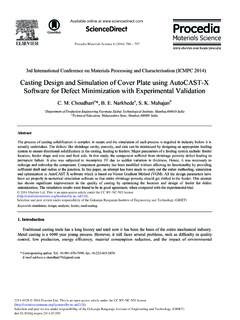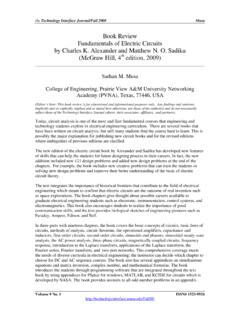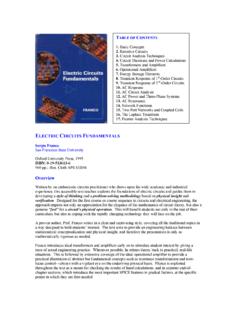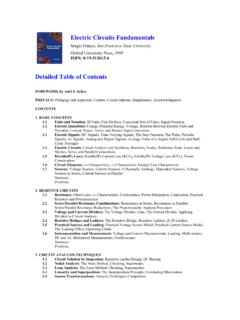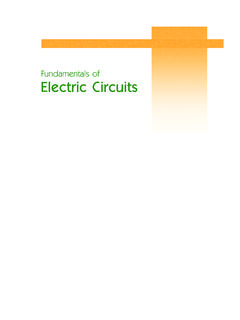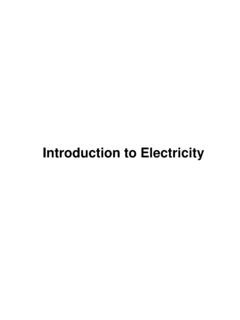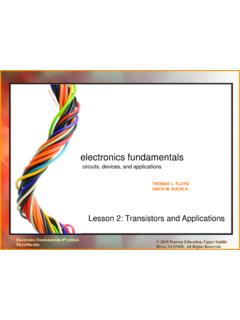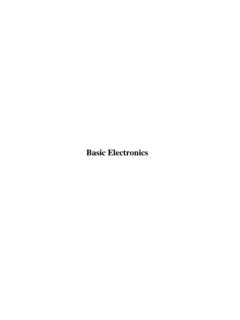Transcription of Fundamentals of Electric Circuits - researchgate.net
1 PreliminariesWhat is a circuitHow to apply these conceptsCoordinated IdeasSummaryFundamentals of Electric CircuitsIUCEE GENTLES udha BalagopalanProfessor, Department of Electrical and Electronics EngineeringPrincipal, Vidya Academy of Science and TechnologyIUCEE5th OCTOBER 2014 Sudha BalagopalanGENTLEP reliminariesWhat is a circuitHow to apply these conceptsCoordinated IdeasSummaryOutline1 PreliminariesLearning OutcomesLinking Fundamentals to learning outcomes2 What is a circuitCircuit and CurrentSource- Load approachLoad components3 How to apply these conceptsSome DC based problemsWhere students face difficulties4 Coordinated IdeasGeneralitiesTransientsSudha BalagopalanGENTLEP reliminariesWhat is a circuitHow to apply these
2 ConceptsCoordinated IdeasSummaryLearning OutcomesLinking Fundamentals to learning outcomesOutline1 PreliminariesLearning OutcomesLinking Fundamentals to learning outcomes2 What is a circuitCircuit and CurrentSource- Load approachLoad components3 How to apply these conceptsSome DC based problemsWhere students face difficulties4 Coordinated IdeasGeneralitiesTransientsSudha BalagopalanGENTLEP reliminariesWhat is a circuitHow to apply these conceptsCoordinated IdeasSummaryLearning OutcomesLinking Fundamentals to learning outcomesExpected Learning OutcomesLearning ObjectivesThis introductory lesson in circuit theory shallenable students toTransit from Knowledge level to Understanding level How?
3 By coordinating ideas, based on acquired knowledgein a systematic mannerVia internalizing a few intuitive approaches for solvingdifferent types of problemsThrough some corroborating case studies orexpository circuit theory problemsSudha BalagopalanGENTLEP reliminariesWhat is a circuitHow to apply these conceptsCoordinated IdeasSummaryLearning OutcomesLinking Fundamentals to learning outcomesExpected Learning OutcomesLearning ObjectivesThe students, as per Bloom s taxonomy, willalso be able toStrengthen analytical skills and applicationcapabilities.
4 How?Via a strong grounding in fundamental conceptsThrough a novel perspective on circuit componentsSolving Circuits by intuitive focusing & observingcrucial featuresSudha BalagopalanGENTLEP reliminariesWhat is a circuitHow to apply these conceptsCoordinated IdeasSummaryLearning OutcomesLinking Fundamentals to learning outcomesExpected Learning OutcomesLearning ObjectivesAt a higher level, students will be empowered toSynthesize Circuits to solve local problems;evaluate available solution methods. How?Examining some innovative examplesLearning to separate the relevant from the triviaKindling the imagination to visualize the problem inthe mind s eyeSudha BalagopalanGENTLEP reliminariesWhat is a circuitHow to apply these conceptsCoordinated IdeasSummaryLearning OutcomesLinking Fundamentals to learning outcomesOutline1 PreliminariesLearning OutcomesLinking Fundamentals to learning outcomes2 What is a circuitCircuit and CurrentSource- Load approachLoad components3 How to apply these conceptsSome DC based problemsWhere
5 Students face difficulties4 Coordinated IdeasGeneralitiesTransientsSudha BalagopalanGENTLEP reliminariesWhat is a circuitHow to apply these conceptsCoordinated IdeasSummaryLearning OutcomesLinking Fundamentals to learning outcomesMotivationSignificance of the topicTo urge students to think at length, in breadth, indepth (& enjoy the teaching- learning in a class)To make students link topics and feel the power ofacquiring clarity in fundamentalsTo convey to students the direct benefits: Technicalmaturity & respect earnedIncrease their capacity for comprehension &coordination of ideasEmpower students to build a good foundation forhigher learningTo enable students to design experiments or createplatforms for project BalagopalanGENTLEP reliminariesWhat is a circuitHow to apply these conceptsCoordinated IdeasSummaryLearning OutcomesLinking Fundamentals to learning outcomesFundamentals of Electric CircuitsLearning OutcomesKnowledge obtained later must not question Understanding already acquiredLearning
6 Must be wholesome; improve thinkingprocess of studentsAssimilated concepts must extend to creativeapplication & analysis of circuit ideasLearning must link between concepts; triggercuriosity based learningModeling and Synthesis must be from a practicalstand-point with justification for choicesLearning must generate innovative ideas; stimulateconcern for local needsSudha BalagopalanGENTLEP reliminariesWhat is a circuitHow to apply these conceptsCoordinated IdeasSummaryCircuit and CurrentSource- Load approachLoad componentsOutline1 PreliminariesLearning OutcomesLinking Fundamentals to learning outcomes2 What is a circuitCircuit and CurrentSource- Load approachLoad components3 How to apply these conceptsSome DC based problemsWhere students face difficulties4 Coordinated IdeasGeneralitiesTransientsSudha BalagopalanGENTLEP reliminariesWhat is a
7 CircuitHow to apply these conceptsCoordinated IdeasSummaryCircuit and CurrentSource- Load approachLoad componentsNetwork to Current to circuit , to Sources &LoadsAny network may have sources and when the circuit is complete a current flowsRather, a current emerges from a source ONLY if itcan return to the source in its the path seen by the current in its travel is whatis the impedance of the circuitSource & Load: Distinction made using BOTHC urrent & VoltageSudha BalagopalanGENTLEP reliminariesWhat is a circuitHow to apply these conceptsCoordinated IdeasSummaryCircuit and CurrentSource- Load approachLoad componentsNetwork- Current- circuit -Sources & LoadsInferencesNetwork is thus a bit of hardware, functional only withcurrent (software)
8 FlowFor a current to flow, n/w must have energy resourcesA current exits a source with the promise to returnImpedance of a circuit is nothing but a manifestationof conservation lawsIf current does not flow thro a n/w segment, thatsegment does not exist in circuit analysisSource- Load: A giver-taker role, show-casing dualitySudha BalagopalanGENTLEP reliminariesWhat is a circuitHow to apply these conceptsCoordinated IdeasSummaryCircuit and CurrentSource- Load approachLoad componentsOutline1 PreliminariesLearning OutcomesLinking Fundamentals to learning outcomes2 What is a circuitCircuit and CurrentSource- Load approachLoad components3 How to apply these conceptsSome DC based problemsWhere students face difficulties4 Coordinated IdeasGeneralitiesTransientsSudha BalagopalanGENTLEP reliminariesWhat is a circuitHow to apply
9 These conceptsCoordinated IdeasSummaryCircuit and CurrentSource- Load approachLoad componentsThe Fundamentals of Source-Load approachApproach based on the Giver-Taker relationshipConservation laws, duality principle, Lenz s law ..applySourceTypes: chemical (using inner potential);electro-mechanical ( using Kinetic energy)Stimuli; excitation; cause- effect or input- outputCurrent & voltage simultaneously have samedirectionsLoadR-L-C; Not necessarilyReaction; Response; cause- effect or input- outputAt a point of time current & voltage directions opposeSudha BalagopalanGENTLEP reliminariesWhat is a circuitHow to apply these conceptsCoordinated IdeasSummaryCircuit and CurrentSource- Load approachLoad componentsDuality in the approach and elsewhereElectric FieldMagnetic FieldVoltageCurrentPotential EnergyKinetic EnergyCharge basedFlux basedCapacitorInductorConstant Charge Theorem Constant Flux Linkage TheoremCV=QLI=N Open circuit to DCShort circuit to DCSudha BalagopalanGENTLEP
10 ReliminariesWhat is a circuitHow to apply these conceptsCoordinated IdeasSummaryCircuit and CurrentSource- Load approachLoad componentsOutline1 PreliminariesLearning OutcomesLinking Fundamentals to learning outcomes2 What is a circuitCircuit and CurrentSource- Load approachLoad components3 How to apply these conceptsSome DC based problemsWhere students face difficulties4 Coordinated IdeasGeneralitiesTransientsSudha BalagopalanGENTLEP relimi






